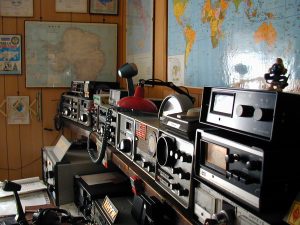 In a document sent to the Secretariat of the Antarctic Treaty
In a document sent to the Secretariat of the Antarctic Treaty  regarding the “Italian activities in Antarctica before the establishment of the PNRA” (and shown during the Consultative Meeting in Paris last June 2021) there is a paragraph concerning the expedition of Renato Cepparo (pic aside Ham callsign I1SR), with mention of the Memorial building, located in Cervignano del Friuli (Italy), inspired by the remains of the base dedicated to Giacomo Bove.
regarding the “Italian activities in Antarctica before the establishment of the PNRA” (and shown during the Consultative Meeting in Paris last June 2021) there is a paragraph concerning the expedition of Renato Cepparo (pic aside Ham callsign I1SR), with mention of the Memorial building, located in Cervignano del Friuli (Italy), inspired by the remains of the base dedicated to Giacomo Bove.
.
The efforts of prof. PHD Julius Fabbri IV3CCT have been rewarded!
.
Here below, the subject:
Italian activities in Antarctica before the institution of the Italian National Research Program in Antarctica (PNRA)
 The largest and only independent Italian Antarctic Expedition was led by Renato Cepparo in 1976-77 to the South Shetland Islands by the Norwegian ship P/V Rig Mate.
The largest and only independent Italian Antarctic Expedition was led by Renato Cepparo in 1976-77 to the South Shetland Islands by the Norwegian ship P/V Rig Mate.
It was privately funded and fully self-sufficient, and had the aim of carrying out scientific measurements and leaving a permanent refuge on the Antarctic Peninsula.
Fifteen men, among whom were the deputy leader Flavio Barbiero, a medical doctor, two divers, and four mountaineers who climbed seven peaks on King George Island, were put ashore at King George Island.
The geologists Gian Camillo Cortemiglia and Remo Terranova were in charge of the scientific part.
Cepparo and his companions landed on King George Island and erected a small building that they named after Giacomo Bove. Today the only remains are the abandoned walls of the station and a wooden table, inscribed by Ing. Admiral Flavio Barbiero.
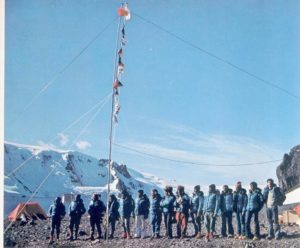 The area still keeps the name Italia Valley.
The area still keeps the name Italia Valley.
In 2018 in Cervignano del Friuli (Italy), the AdiriAntarctica NGO has made an “Italia Valley Antarctic Memorial” of this expedition, building a 1:1 scale replica of the wooden table and the ruins of the Renato Cepparo- Giacomo Bove Station as open-air part of an indoor permanent Museum of Italia Valley, an example of ex situ conservation.
The Italia Valley location.
The Milanese entrepreneur Renato Cepparo left Lisbon on December 22nd 1975 aboard the 900-ton Norwegian polar ship Rig Mate, heading for Antarctica with a shipment of 15 men_ The group included geologists, glaciologists, biologists, mountaineers, experienced divers and nine creme.
Scientists stopped on King George Island where they established a small prefabricated field in the Admiralty Bay named after Giacomo Bove. Others headed for the Wiencke Island and Livingstone Islands to make the planned climbs.
Pic on the Right shows: 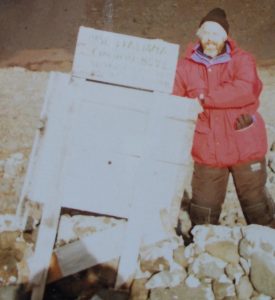 Remains of Giacomo Bove Station (Cepparo’s Team did operate HF radio using I1SR/P callsign)- Picture taken in 1998.
Remains of Giacomo Bove Station (Cepparo’s Team did operate HF radio using I1SR/P callsign)- Picture taken in 1998.
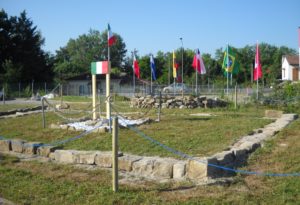 Pic on the Left shows;
Pic on the Left shows;
Scaled 1:1 replica of wooden table and station ruins at “Italia Valley, Antarctic Memorial’ in the park of “A. Malignani” High School of Cervignano del Friuli – Italy
IV3CCT & II3BOVE (pic aside) is proud to see his efforts recognized by the Institutions and wish to expree his gratitude to those who in any form of support did allow to put, to the international attention, an Antarctic Operation done by Renato Cepparo and his Team back in 1976-77.
«Dear friends and supporters, after twenty years of research; after 12 battles with the MAE and MAECI (Foreign Min.) and clashes with scientific diplomacy, finally, the Dicastery has published, on behalf of Italy, an article mentioning “our” Memorial!
Many thanks to those who have supported me over the years!
Even if there are errors and omissions in this documents, it’s anyway important that the Memorial was published by Italy which, in this way, did accredit it !
 A real honor for me, for the relatives of Renato Cepparo and Giacomo Bove as well as for students, families, associations, partners and patrons. The Giacomo Bove and Maranzana (AT) Association and the Cultural Adri-Antartica Association, founders of the actually constituted National Consortium. All together, say thank you to all the supporters, to friends and families. Thanks to the late H.E. Ambassador Arduino Raimondo Fornara, yp Commander Gen. Amedeo Amedeo G. Cristofaro, to H.E. Ambassador Pier Francesco Zazo, graduated with prof. Silvio Zavatti.»
A real honor for me, for the relatives of Renato Cepparo and Giacomo Bove as well as for students, families, associations, partners and patrons. The Giacomo Bove and Maranzana (AT) Association and the Cultural Adri-Antartica Association, founders of the actually constituted National Consortium. All together, say thank you to all the supporters, to friends and families. Thanks to the late H.E. Ambassador Arduino Raimondo Fornara, yp Commander Gen. Amedeo Amedeo G. Cristofaro, to H.E. Ambassador Pier Francesco Zazo, graduated with prof. Silvio Zavatti.»
Thanks indeed de Julius IV3CCT & II3BOVE
Pic above shows Prof Phd Julius Fabbri IV3CCT at the Foreign Ministrer in Rome
See also: http://www.waponline.it/italia-valley-memorial-a-great-job/
 Observation Hill is also known for being the site where a Cross was erected as memorial to Robert Falcon Scott and his South Pole Party.
Observation Hill is also known for being the site where a Cross was erected as memorial to Robert Falcon Scott and his South Pole Party.
 This “brief life” Research site, was very singular! It was set on Pobeda Ice Island (original Russian name “Oстров Победы” aka Victory Island) in the Mawson Sea, about 160 km off the coast of Queen Mary Land, East Antarctca.
This “brief life” Research site, was very singular! It was set on Pobeda Ice Island (original Russian name “Oстров Победы” aka Victory Island) in the Mawson Sea, about 160 km off the coast of Queen Mary Land, East Antarctca. winter solstice in Antarctica, the crew at Concordia Research Station (WAP MNB-Ø3) are slowly welcoming the return of sunlight.
winter solstice in Antarctica, the crew at Concordia Research Station (WAP MNB-Ø3) are slowly welcoming the return of sunlight.  In a document sent to the Secretariat of the Antarctic Treaty
In a document sent to the Secretariat of the Antarctic Treaty  regarding the “Italian activities in Antarctica before the establishment of the PNRA” (and shown during the Consultative Meeting in Paris last June 2021) there is a paragraph concerning the expedition of
regarding the “Italian activities in Antarctica before the establishment of the PNRA” (and shown during the Consultative Meeting in Paris last June 2021) there is a paragraph concerning the expedition of  The largest and only independent Italian Antarctic Expedition was led by Renato Cepparo in 1976-77 to the South Shetland Islands by the Norwegian ship P/V Rig Mate.
The largest and only independent Italian Antarctic Expedition was led by Renato Cepparo in 1976-77 to the South Shetland Islands by the Norwegian ship P/V Rig Mate. The area still keeps the name Italia Valley.
The area still keeps the name Italia Valley. Remains of Giacomo Bove Station (Cepparo’s Team did operate HF radio using I1SR/P callsign)- Picture taken in 1998.
Remains of Giacomo Bove Station (Cepparo’s Team did operate HF radio using I1SR/P callsign)- Picture taken in 1998. Pic on the Left shows;
Pic on the Left shows;
 A real honor for me, for the relatives of Renato Cepparo and Giacomo Bove as well as for students, families, associations, partners and patrons. The Giacomo Bove and Maranzana (AT) Association and the Cultural Adri-Antartica Association, founders of the actually constituted National Consortium. All together, say thank you to all the supporters, to friends and families. Thanks to the late H.E. Ambassador Arduino Raimondo Fornara, yp Commander Gen. Amedeo Amedeo G. Cristofaro, to H.E. Ambassador Pier Francesco Zazo, graduated with prof. Silvio Zavatti.»
A real honor for me, for the relatives of Renato Cepparo and Giacomo Bove as well as for students, families, associations, partners and patrons. The Giacomo Bove and Maranzana (AT) Association and the Cultural Adri-Antartica Association, founders of the actually constituted National Consortium. All together, say thank you to all the supporters, to friends and families. Thanks to the late H.E. Ambassador Arduino Raimondo Fornara, yp Commander Gen. Amedeo Amedeo G. Cristofaro, to H.E. Ambassador Pier Francesco Zazo, graduated with prof. Silvio Zavatti.»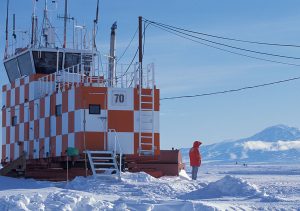 McMurdo Station has no permanent residents — just a revolving door of visiting scientists and temporary personnel, some of whom live there for up to a year at a time. At its most populous, typically during the summer, it houses about 1,000 people.
McMurdo Station has no permanent residents — just a revolving door of visiting scientists and temporary personnel, some of whom live there for up to a year at a time. At its most populous, typically during the summer, it houses about 1,000 people. The Unión Glacier, located at 79º 46’ South, 83º 24’ West, is a large glacier converted since 2014 into the Base Camp.
The Unión Glacier, located at 79º 46’ South, 83º 24’ West, is a large glacier converted since 2014 into the Base Camp.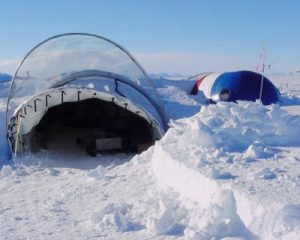 In 2013 during the 68th Chilean Antarctic Campaign (ECA 50), the Polar Stations Arturo Parodi Alister (WAP CHL-14) –Picture here on the Right shows the entrance of Arturo Parodi Alister Base – established at Patriot Hills in 1996, and Antonio Huneeus Gana, were dismantled. Their equipments moved to the corridors of the future station, the Unión Glacier joint scientific polar station.
In 2013 during the 68th Chilean Antarctic Campaign (ECA 50), the Polar Stations Arturo Parodi Alister (WAP CHL-14) –Picture here on the Right shows the entrance of Arturo Parodi Alister Base – established at Patriot Hills in 1996, and Antonio Huneeus Gana, were dismantled. Their equipments moved to the corridors of the future station, the Unión Glacier joint scientific polar station.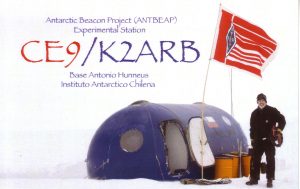
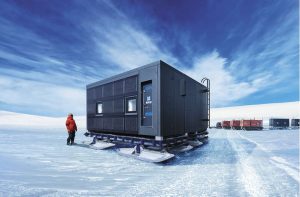 Japan will soon begin working toward construction of a new Antarctic base to continue with research into climate change over the past 1 million years.
Japan will soon begin working toward construction of a new Antarctic base to continue with research into climate change over the past 1 million years. Endurance22 will launch early next year with aim of locating and surveying wreck of Sir Ernest Shackleton’s ship Endurance in the Weddell Sea.
Endurance22 will launch early next year with aim of locating and surveying wreck of Sir Ernest Shackleton’s ship Endurance in the Weddell Sea.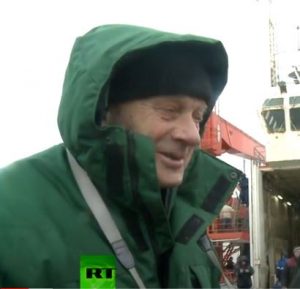 There is a very important person, leading expert of the Russian Antarctic Expedition of the Arctic and Antarctic Research Institute, one of the few people to receive the Order “For Naval Merit” (Russian: Орден «За морские заслуги»), a state decoration of the Russian Federation bestowed for excellence in military or economic maritime endeavours, Awarded for Excellence in worldwide oceanic activities in favour of Russian military and economic security.
There is a very important person, leading expert of the Russian Antarctic Expedition of the Arctic and Antarctic Research Institute, one of the few people to receive the Order “For Naval Merit” (Russian: Орден «За морские заслуги»), a state decoration of the Russian Federation bestowed for excellence in military or economic maritime endeavours, Awarded for Excellence in worldwide oceanic activities in favour of Russian military and economic security.